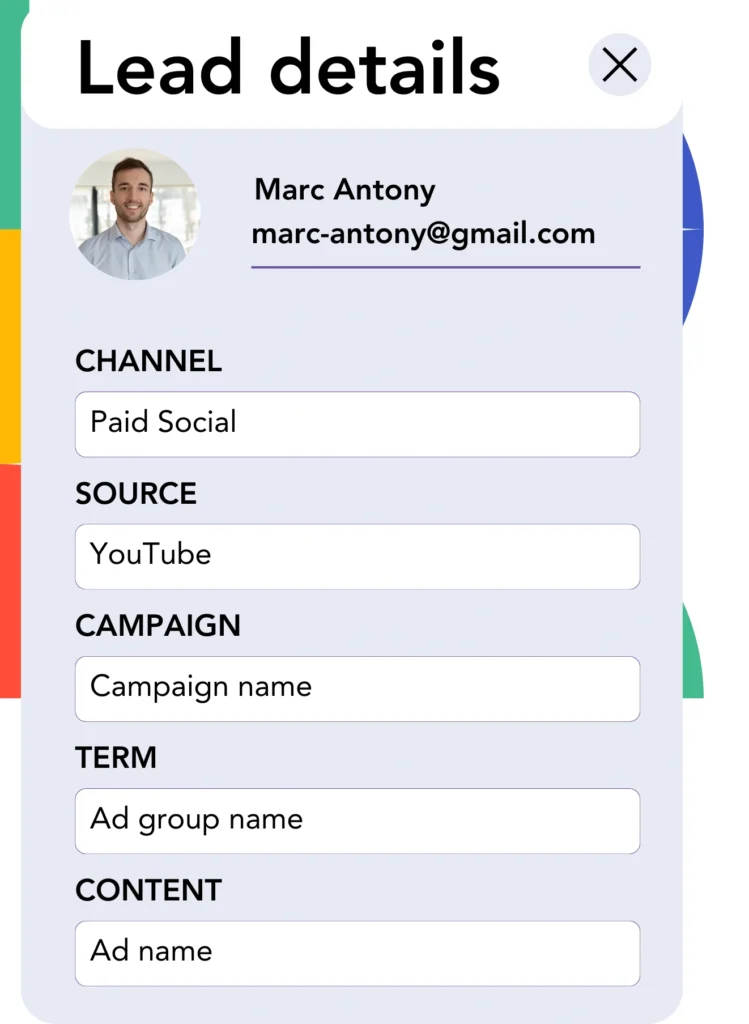You capture leads on YouTube and transfer them to Zoho CRM, but it’s impossible to track each lead to a particular YouTube ad. Similarly, once a lead converts into a customer, there’s no method to associate that customer back to a precise YouTube ad.
This inability to track your YouTube ads prevents you from measuring their performance, leaving you unsure which ads are effectively generating leads and customers. Consequently, you invest in multiple ads without a clear understanding of their effectiveness.
Fortunately, there’s a simple method to connect each lead to the exact YouTube campaign, ad group, and ad responsible for it.
Let’s walk through it one step at a time!
How to Track YouTube Ads in Zoho CRM
Step 1: Add Leadsources in the head tag of your website

Leadsources is an easy-to-use tool that tracks where your leads come from. Once installed on your website, it collects up to 7 pieces of source data for each lead you generate.
➡️ Sign up to Leadsources.io for free
➡️ Add the Leadsources tracking code to your site
Step 2: Add the UTM parameters to your YouTube Ads

In your ad URL, include UTM parameters to collect YouTube ad data, such as campaign, ad group, and specific ad. You could try using the following:
UTM_source=YouTubeUTM_campaign=campaign-nameUTM_term=ad-group-nameUTM_content=ad-name
The completed URL should appear like this:
https://www.yourdomain.com/?&UTM_source=youtube&UTM_campaign=campaign-name&UTM_term=ad-group-name&UTM_content=ad-nameNote: Leadsources tracks lead source data even without UTM parameters, ensuring complete tracking for each lead.
Step 3: Add the hidden fields in your form

Hidden fields are form elements that users can’t see, but they hold data that is submitted with the form.
Leadsources stores lead source information in these hidden fields. When a lead submits the form, Leadsources automatically populates these fields with YouTube Ads data.
Step 4: Capture the YouTube Ads data in Zoho CRM

When users click on your ads and arrive on your site, Leadsources fetches the YouTube campaign, ad group, and ad data, among other details.
Leadsources then populates the hidden fields of your form with this YouTube ad data.
Once the form is submitted, you can access the YouTube ad data along with the lead details in Zoho CRM (you’ll need to connect your form to Zoho CRM).
How does Leadsources work?
When someone visits your site, Leadsources fetches YouTube ad data and populates it into the hidden fields of your form. After submission, this data, along with lead details like name and email, is sent to Zoho CRM.
Leadsources captures all the lead source data for every individual lead:
| Lead source data | Fetched automatically |
| Channel | ✅ |
| Source | ✅ |
| Campaign | ✅ OR use UTM_campaign |
| Content | UTM_content parameter is required |
| Term | UTM_term parameter is required |
| Landing page | ✅ |
| Landing page subfolder | ✅ |
As illustrated in the table above, even when UTM parameters are not applicable—like with organic sources such as Google search or when your website is published in an article—Leadsources still captures the following lead source data:
- Channel
- Source
- Campaign
- Landing page
- Landing page subfolder
Unlike many other tools, Leadsources monitors lead sources across all marketing channels, whether organic or paid.
Performance reports: Lead, sales, and revenue by source
Tracking YouTube Ads data in Zoho CRM allows you to generate performance reports like:
- Leads, sales, and revenue by channel
- Leads, sales, and revenue by source
- Leads, sales, and revenue by campaign (aka. YouTube campaign)
- Leads, sales, and revenue by term (aka. YouTube ad group)
- Leads, sales, and revenue by content (aka. YouTube ad)
This enables you to adjust your YouTube Ads budget according to the campaigns, ad groups, and ads that generate the most leads, sales, and revenue.
Let’s explore some of the reports you can create!
1. Lead source reports
Generate performance reports showing the number of leads produced by:
- Channel
- Source
- Campaign (aka. YouTube campaign)
- Term (aka. YouTube ad group)
- Content (aka. YouTube ad)
- Landing page
- Landing page subfolder
Example #1: Leads by channel
This report allows you to identify the channel that produces the most leads.

Example #2: Leads by YouTube campaign
You can now concentrate on a particular lead source (e.g., YouTube) and monitor the leads generated by each YouTube campaign.

Example #3: Leads by YouTube ad
Once you identify the YouTube campaign that brings in the most leads, you can examine which ad group or ad is responsible for generating those leads.

2. Sales and revenue source reports
Now that we know which YouTube campaign, ad group, and ad are generating our leads, the next step is to find out if these leads are converting into sales and revenue.
To achieve this, connect your leads to a CRM such as Zoho CRM. This allows you to monitor sales and revenue coming from different channels, sources, YouTube campaigns, ad groups, ads, landing pages, and subfolders.
With this data, you can optimize your YouTube Ads strategy by focusing on the channels, sources, campaigns, ad groups, and ads that drive the most sales and revenue.
You can create various reports to track sales and revenue, including:
- Sales and revenue by channel
- Sales and revenue by source
- Sales and revenue by campaign
- Sales and revenue by term (e.g., YouTube ad group)
- Sales and revenue by content (e.g., YouTube ad)
- Sales and revenue by landing page
- Sales and revenue by landing page subfolder
Example Scenario:
| Channel | Search Paid | Social Paid |
|---|---|---|
| Leads | 50 | 75 |
| Sales | 5 | 6 |
| Average Order Value | $150 | $100 |
| Revenue | $750 | $600 |
Once the ads were launched on Google and YouTube, the first “Leads by Channel” report indicated that YouTube (Social Paid) outperformed Google (Search Paid) in lead generation.
However, after reviewing the sales and revenue data in Zoho CRM, you found that the Search Paid channel generated more revenue with fewer leads than the Social Paid channel. As a result, you decided to reallocate your budget, focusing more on the Search Paid channel.
LeadSources tracks the source of each lead in Zoho CRM, whether they come from ads, organic search, social, email, etc. and syncs that data with each submission. See the full breakdown on the lead source in Zoho CRM page.

